Lone Khalsa Warrior
 A contingent of Turkish soldiers is on active patrol. The area rulers have specifically assigned this contingent to keep a watch over the Sikh jatha that had gathered in Majha and would surely proceed to Anandpur Sahib for participating Dashmesh father's (Sri Guru Gobind Singh) Dharam Yudh. Additional responsibilities assigned to this contingent included, instilling fear among people who either express sympathy with the Sikh jatha or welcome it or serve it any way. For this reason, the Turkish contingent always moved ahead of the Sikh Jatha.
A contingent of Turkish soldiers is on active patrol. The area rulers have specifically assigned this contingent to keep a watch over the Sikh jatha that had gathered in Majha and would surely proceed to Anandpur Sahib for participating Dashmesh father's (Sri Guru Gobind Singh) Dharam Yudh. Additional responsibilities assigned to this contingent included, instilling fear among people who either express sympathy with the Sikh jatha or welcome it or serve it any way. For this reason, the Turkish contingent always moved ahead of the Sikh Jatha. 
Three miles from the road leading to Anandpur Sahib in Hoshiarpur District, is a village, named Talban. Bibi Deep Kaur, the subject of our story, was resident of this village. There was only one Sikh house in this village -- Bibi Deep Kaur's residence. Today her husband wasn't home. He had already left for participating in Dashmesh father's Dharam Yudh. When Bibi heard of Jatha's arrival, she was filled with emotions of self-service. She explained her emotions and desire to other women in her neighbourhood. But the Turkish soldiers had successfully frightened the residence of this village. Thus no one was willing to accompany her.
"Let them not proceed, if someone doesn't want to" Bibi Deep Kaur told herself. For how could one stay behind if they have even the slightest love for the Guru in their heart. Holding onto the quest of love and a glimpse of the Sikh Jatha, Bibi Deep Kaur proceeded alone and awaited the arrival of Sant-Sipahis.
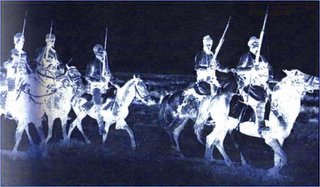 Suddenly dust arose from afar. Her face brightened with joy. Her quest for Jatha's sight grew stronger. Now she started walking on the road toward the rising dust storm. Soon she realised that this was not the Jatha of Sant- Sipahis. Rather it was the contingent of evil Turkish soldiers. Surprised, she quickly moved off the road and tried to hide herself by sitting next to a tree.
Suddenly dust arose from afar. Her face brightened with joy. Her quest for Jatha's sight grew stronger. Now she started walking on the road toward the rising dust storm. Soon she realised that this was not the Jatha of Sant- Sipahis. Rather it was the contingent of evil Turkish soldiers. Surprised, she quickly moved off the road and tried to hide herself by sitting next to a tree.As the Turkish contingent got closer, it's commander caught sight of Deep Kaur. Seeing the youthful beauty, he lost all self-control.
He commandingly asked. "Who are you?"
"Whoever I am. How does it matter to you?" She answered fearlessly.
Commander's attraction grew stronger with her challenge.
He remarked softly, "By Shehansha's (ruler's) orders, I have been deputed to keep a watch on Sikhs in this area. Since the Sikh Jatha is heading this way, I need to ascertain whether you are a Sikh."
"If I were to be a Sikh, then?"
"Then we will have to arrest and sent you to Lahore." Deep Kaur heard his response.
But, being a Sikh how could she lie. Fearlessly, she announced, "I am Sikh."
The Turk Commander was astonished by her fearlessness. But as captive of her beauty, by now, he was aroused beyond any self-control. He spoke softly and said, "Beautiful, I am responsible for capturing Sikhs. You are a Sikh. I should arrest you, but I cannot do that. I cannot fulfil my responsibilities. For I have a heart that worships beauty and it is yours now. I am your captive."
Deep Kaur's face reddened with anger. She lashed out saying, "You should be ashamed of yourself talking to me like this."
"What is there to be ashamed of where hearts have met? I am yours. Accept me and I shall keep you as my Begum (wife)." He said.
"I am a Sikh and married. If you ever uttered anything like this again I will snatch your tongue." Deep Kaur responded. By now she was shaking with anger.
"What kind of a beauty it would be that doesn't exhibit enticing or alluring behaviour? I am impressed by your behaviour. Now don't delay anymore and let's go. What are you going to get from these wild Sikhs?" Saying this, the commander dismounted from his horse and moved towards Deep Kaur while his contingent waited on the opposite side of the road.
As he dismounted, Deep Kaur stood up. Seeing him approach her, she challengingly said "Beware, if you touch my body I will not spare you."
Insane under arousal, the commander ignored her warning and instead proceeded to hug her. Deep Kaur pulled back with lightening speed. By now she had the small kirpan in her hand. As the commander approached, struck him in his stomach wit
 h the kirpan. A blood spring burst opened. With painful cries, he simply dropped to the ground.
h the kirpan. A blood spring burst opened. With painful cries, he simply dropped to the ground.By now the Daughter of the Khalsa had jumped into the war. As the wounded Commander sat on the ground, she viciously attacked him once again, sending his evil soul to burn in hell. Before, the Turkish soldiers could advance; she moved swiftly to take control of the commander's sword and was well-prepared for self-defense. Seeing their dying commander, the soldiers advanced shaking in anger and simultaneously attacked her.
However, the Daughter of the Khalsa wasn't scared being out-numbered. Like a Brave Lioness, she stood fast for the challenge. She used the sword like a Khalsa and soon two soldiers fell to the ground while several others were severely wounded. Deep Kaur too sustained deep wounds on her face and neck. Although her wounds were profusely bleeding, she kept her courage and continued fighting like a Khalsa. The Turkish soldiers were challenged by a Khalsa Woman.
Far on the road, the sound of horses could be heard once again. This time the Sant-Sipahi's Jatha was approaching. As the Turkish soldiers saw the Sikh Jatha, they got scared, immediately mounted their horses and ran for their lives. The bodies of the Commander and five of his associates were left behind, lying cold on the ground.

The sight of approaching Sikh brothers filled Deep Kaur filled with joy. She quickly tried to move towards the road but couldn't. She had lost too much blood and thus was unable to walk. She simply fell unconscious to the ground. Sikh Jatha saw unconscious Deep Kaur and 6 dead bodies of Turkish soldier, upon reaching the location. It did not take them long to comprehend the situation.
Immediately, they spread a bed for Dashmesh's Daughter, dressed her wounds and awaken her with medication. Then carrying her along, the Jatha proceeded to Anandpur Sahib for participating in the Dashmesh father's Dharam Yudh.
Fully aware of the situation, our Dashmesh father Sri Guru Gobind Singh Ji was strolling outside his court awaiting the arrival of this Jatha. Seeing them arrive, he joyfully advanced to receive them and asked "Where is my daughter?"
Jatha members were confused. They did not understand the meaning of this question, since there were many Sikh women among the Jatha. Who did Guru Sahib honour with daughter's address? They could not understand.
In the meantime, Guru Sahib quickly moved towards the palki (palanquin) carrying the wounded Deep Kaur. Raising the palki curtain, he hugged and kissed her forehead, saying "This is my Daughter Deep Kaur. Because of such daughter my Panth shall remain in Chardi Kala”
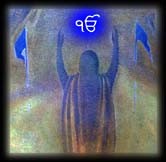
"I have made this body and mind a sacrifice, a sacrificial offering to the Lord. Dedicating my body and mind, I have crossed over the terrifying world-ocean, and shaken off the fear of death."
(Guru Arjan Dev Ji, Chant, Anng. 576)
Spiritual Strength of a Sikh Woman
 With the Vaisakhi celebrations and the coming of the millennium, Shanti Kaur Khalsa assesses the spiritual position and strength of Sikh women. Drawing from both Sikh philosophy and personal experiences, she demonstrates the importance of being a Sikh woman in today’s world...
With the Vaisakhi celebrations and the coming of the millennium, Shanti Kaur Khalsa assesses the spiritual position and strength of Sikh women. Drawing from both Sikh philosophy and personal experiences, she demonstrates the importance of being a Sikh woman in today’s world... As we enter the change of the millennium, the role of the woman has changed and will continue to change dramatically. Striving to maintain ourselves in the age of technology, we find years pass with such speed and anxiety that sometimes we do not know what maintains us except the blessing of God’s companion. A woman carries the responsibility of the physical, mental and spiritual well being of her family. This is a serious job that can reap great rewards, but also carries dire consequences when not done successfully. In addition to that, many women have added the weight of work and career. When there is constant pressure and no relaxation, when there is no outlet, when there is a constant deficit in our mental and physical capacity, it results in a shattered mind and the loss of happiness and inner peace. We suffer as women, and our generations suffer as a result. This is a dilemma that is shared by women in every country, of every religion, on every continent.
With the tri-centenary of the Khalsa, we find that Sri Guru Gobind Singh Ji gave us the answers to these modern age problems more than three hundred years ago. Woman is strong by nature. Woman is spiritual by nature. By fine-tuning our uniquely feminine attributes with the Guru’s Rehat, Guru Gobind Singh assures us purity. We become not women, not men, but something far and beyond…we become KHALSA! In these difficult times, it is required that a woman should not only be pure. She needs to be purifying. Her very presence should create an effect on her surroundings that uplifts and illuminates those with whom she comes in contact. The formula is clear, the solution is simple in nature, and success is guaranteed. This is the simple strategy of:
Bani
Simran
Seva
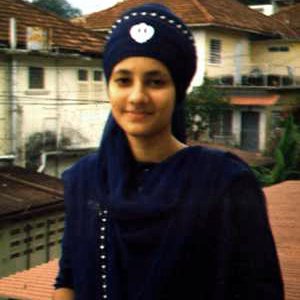 Bana is our own flag. Bana is our nishan that states unequivocally who we are. If we have the dress and fashion of a movie star, that makes a statement as to who we are. If we wear the clothes of a beggar, that also tells the world what our status is. And if we wear the bana of the Khalsa, this makes a statement of strength that cannot be ignored by the hardest of hearts. Bana is the image and dress of grace. Bana is the five K's of the Khalsa: Kesh, Kacherha, Kanga, Kara, and Kirpan. Each one of these beautiful accoutrements gives us strength and beauty. Bana is a statement that says, with a look, that I belong to Guru Gobind Singh, and He belongs to me.
Bana is our own flag. Bana is our nishan that states unequivocally who we are. If we have the dress and fashion of a movie star, that makes a statement as to who we are. If we wear the clothes of a beggar, that also tells the world what our status is. And if we wear the bana of the Khalsa, this makes a statement of strength that cannot be ignored by the hardest of hearts. Bana is the image and dress of grace. Bana is the five K's of the Khalsa: Kesh, Kacherha, Kanga, Kara, and Kirpan. Each one of these beautiful accoutrements gives us strength and beauty. Bana is a statement that says, with a look, that I belong to Guru Gobind Singh, and He belongs to me. -Sri Guru Gobind Singh Ji
If the Khalsa maintains the distinct path,
I shall give them all my strength.
But if the Khalsa leaves this path,
then I will withdraw my recognition.
Well, as a young woman of 18 years, full of the spirit of life and the excitement of discovering the teachings of Guru Gobind Singh Ji, it never occurred to me to not wear a turban. The Khalsa of Sri Guru Gobind Singh Ji wore the dastar, and that was who I wanted to be. So it was with great sincerity that I tied my first turban.
As you can imagine, the most dramatic effect of wearing a turban is not physiological, but rather it is social. Wearing a turban gave me pride and confidence. My parents and my friends were stunned. They thought they had lost me, but of course they had not Rather the experience of being distinct has made me more committed to the welfare of those around me, because everything I do is highlighted and examined by others.
Now that I have lived my life experiencing the benefits of the turban, I can tell you honestly that you are missing a great advantage by not doing so. I have been given the respect and the status of a spiritual woman, even when I myself have been filled with self-doubt and misgivings. This I see as Sri Guru Gobind Singh Ji fulfilling his promise, giving me strength even when I do not have strength myself. This beautiful dastar proclaims to the entire world that I belong to Guru Gobind Singh and that is a reality I will never deny.
BANI (The Word of God):
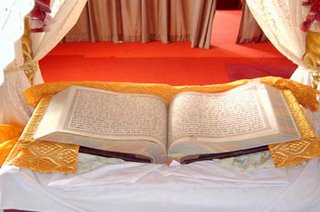
By the Grace of God, we are Sikhs of the Shabd Guru. We bow to no man. We worship no images. We bow to the Word, the Shabd, the sound current. As women, we cannot underestimate the power of our own words and language. Our words contain the power of love and hate, and we should be mindful of how to communicate with all of God's children. How do we do this? Through exercising the daily recitation of Nitnem and Gurbani. The daily prayers of the Sikh are a beautiful form and format that rearranges our neurological processes to provide us with a direct connection with the infinite creative energy of the universe. This is the heart of the Guru's teachings. And if we do not experience this ourselves, we will most likely deny this experience to our children.
Siri Guru Amar Das ji tells us about the power and projection of the Bani:
"Great! Great is the Bani,
the Word of the Formless Lord.
There is no other as Great as He is."
This is why we say that our Guru is the Shabd Guru. The Siri Guru Granth Sahib Ji is not a "book," it is not a "bible;” it is a ‘living Guru’ that guides us, protects us and enlightens us. The whole science of Gurbani has the power to make a person divine just in its recitation. It does not require a deep and scholarly understanding or interpretation for an impact on our consciousness because Bani is understood by the heart, not the head. The entire Siri Guru Granth Sahib is the calling out of the Beloved. A woman does not need to be dependent on sants and preachers, being led around like a donkey with a string in her nose. All that is needed is the inner experience of God that can be brought to us from our own Guru, the Living Guru, the Shabd Guru. That is the miracle, the science, and the blessing of Bani.
SIMRAN (Remembrance of GOD): 
In the first line of Sukhmani Sahib, Sri Guru Arjun Dev Ji tells us:
"To the one who meditates on Him, there comes a perfect peace.
And all pain and sorrows depart.
Meditate on Him, who contains the universe.
Whose Holy Naam is the whisper on the lips of the entire creation. "
Simran provides us with the answer to maintaining our balance and equilibrium. Naam Simran is the use of the Gurmantra; the meditation and recitation of Waheguru. How do you do simran? There are as many answers to that question as there are people to ask. The simply answer is: simran is not a technique but a process. At any time that is peaceful, but especially in the early morning before dawn, sit and concentrate on the Holy Naam. Project out with focused clarity. If you beam the signal out, you will get a clear signal back. This cleanses the subconscious mind, clarifies the conscious mind, and gives us the experience of bliss and peace. In the divinely human experience, we understand our depth and dimension, gaining access to our inner strength, direction and intuition.
Don't you wonder about yourselves sometimes? You are born with no claws, no hoofs, and no superior strength. As a human being it appears we have been born with no defence mechanism. Have we been created by God as the only defenceless creature in His creation? No. Our strength lies in our intuition. When you can intuitively sense what is going to happen, then you can avoid entering a wrong sequence and you will not end up with an unwanted consequence. That is the best defence we could possibly have. And what gives us intuition? The mind. How does the mind develop intuition? Through meditation. Intuition works when there is no fear involved, no greed involved, no attachment involved and no lust involved. The subconscious mind has to be a clear channel and then the conscious mind perceives the information that is coming from the intuition.
We all have that power as human beings because every mind is part of the universal mind. However, women are created with an enhanced subtly, an accentuated sensitivity, which gives us great depth and dimension. For women, simran is an essential tool of life, a quintessential feminine strength. To ignore this aspect is to not water the most beautiful flower that grows in our garden. Simran gives us the key to know ourselves and the ability to know and love God.
SEVA: If the strength of one is great, the strength of the many is even greater. Seva is the knot that ties us to each  other, ties us to our Guru, and transcends us from our own individual consciousness to the expansive nature of universal consciousness. No matter how great our stature, no matter how vast our authority, if we separate and isolate ourselves through the definition of ego, then we are far less than what our potential could be. Service to each other and service to Guru Ji, when done with a loving heart, with no desire for reward, breaks the bonds of ego and frees the soul.
other, ties us to our Guru, and transcends us from our own individual consciousness to the expansive nature of universal consciousness. No matter how great our stature, no matter how vast our authority, if we separate and isolate ourselves through the definition of ego, then we are far less than what our potential could be. Service to each other and service to Guru Ji, when done with a loving heart, with no desire for reward, breaks the bonds of ego and frees the soul.
Guru Amar Das Ji tells us:
"Fruitful is the True Guru's service,
if anyone performs it by engaging his mind in it
Heart desired boons are attained
and ego departs from within."
Throughout Sikh history, women have displayed a seemly endless capacity for seva. Service to others is in our nature, the very bones of our being. It is part of our beauty and part of our strength. By doing seva, we lose the limitations of our finite self, and expand into the infinite strength of the body of the Khalsa. Through seva we remain humble, for seva is an activity that is not recognized as an individual action. The heavy and enormous burden of appreciation and recognition is not a factor in the performance of seva. It is personal, anonymous and deeply expansive. We become part of a whole that is unbreakable and unparalleled. Seva is actually our physical link to the Guru. By serving the Khalsa, we have the experience of serving our Guru, touching that great wisdom with our own hands. Of all the things I have learned in this life, of all the things I wish to teach to the children of is the blessing of living the Rehit (Code of Conduct). This beautiful path, laid down by the Tenth Master, will carry us into the 21st Century with direction and strength. It is the this way of life, and that I pray that they will teach to their children, the most important key to the future, the solution to today's problems, and the answer to tomorrow's questions. As women it is our sacred responsibility to understand it, live it, enjoy it, and teach it to our children
- the next generation of Khalsa!
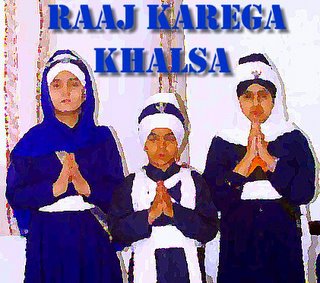
Waheguru Ji Ka Khalsa!
Waheguru Ji Ke Fateh!!
By:Shanti Kaur Khalsa
Crying Children
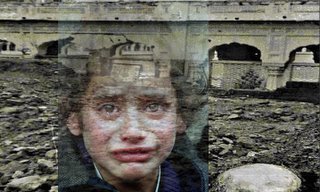 We did our Nitnem
We did our NitnemWe did our Kirtan
We were loved
We were ripped from the arms of our
parents and thrown into the fire
We were nothing more than children
We had a future
We were the face the of this Panth
We had dreams too, then we had no hope
We were taken away in the dead of night
No air to breathe
 Our parents cried as they saw their loved ones bleeding to death
Our parents cried as they saw their loved ones bleeding to deathWe are separated from the world to be no more.
From the ashes, hear our plea
For we were children whose dreams and lives were stolen away!
We will always remember the pain and suffering…
But for the children whose lives were taken away
We shall fight to the very end
And make it clear
We are the next generation
of the Khalsa Panth
 To Learn more about the Sikh Genocide in 1984 Click Here
To Learn more about the Sikh Genocide in 1984 Click HereBut a Daughter of the Khalsa...

A woman of Beauty works out everyday to keep her body in shape
But a Daughter of the Khalsa looks deep inside
to keep her soul in shape
A Powerful woman isn’t afraid of anything
But a Daughter of the Khalsa shows courage
in the midst of her fear
A Outspoken woman won’t let anyone get the best of her
But a Daughter of the Khalsa gives the
best of her to everyone
A Tough woman makes mistakes,
And avoids the same in the future
But a Daughter of the Khalsa realizes life’s mistakes can also be
Blessings and capitalizes on them
A Successful woman walks sure footedly
But a Daughter of the Khalsa
knows when to ask for help
A Rich woman wears the look of confidence on her face
But a Daughter of the Khalsa wears
the look of Grace
A Devoted woman has faith that she is
strong enough for the journey
But a Daughter of the Khalsa has faith that
it is in the journey that she will become strong
-FaujKaur
A Singhnee's Battle

 hat they might turn back any Sikh who wanted to enter the city on the plea that entry to the Sri Harmandir Sahib had been officially banned. While the religious-minded leaders accomplished the task of warning the people, Lahkhpat, on the other hand, stealthily posted a large number of spies around the temple.
hat they might turn back any Sikh who wanted to enter the city on the plea that entry to the Sri Harmandir Sahib had been officially banned. While the religious-minded leaders accomplished the task of warning the people, Lahkhpat, on the other hand, stealthily posted a large number of spies around the temple.He sat on the balcony of a nearby building and waited for the further developments.
Early next morning, Diwan Kaura Mal and Surat Singh rode towards the temple to see what Lakhpat had decided to do, and when they approached the temple, the blissful music of the songs of the devoted Sikhs and their women singing, fell gently like rain in their ears. Both the Diwans were distressed, as they knew Lakhpat’s evil plans. At the same time, they wondered what stuff these Sikhs are made of. They fear not death. Their faith is firm. But the pity is that Lakhu is determined to bathe in the blood of these brave men.
Reflecting for a while, these two men tied their horses and turned towards the tents. They were now near the gateway of the temple, when they saw a young woman whose beauty rivaled the full moon....
She had a soiled round cloth (Dastaar) on her head and a nine-year old child holding her fingers beside her. Both were reciting Gurbani (prayers).
Advancing towards them Diwan Kaura Mal asked them: “Where are you going?”

Singhnee (bowing towards them with folded hands): “We are going to Sri Darbar Sahib.”
Surat Singh’s face was flushed with indignation and he asked them: “From where have you come from? Did no one stop you from coming here?”
With great confidence the Singhnee answered: “I am coming from Tung. Two men met me on the way and told me not to go to the temple, for we would be killed. So I turned back and changed my route and have come back here stealthily through the fields.”
Diwan Kaura Mal: “Do you want to live?”
Singhnee: “There is nothing dearer than one’s life, but ultimately it will also come to an end. Faith will outlive life. Therefore, it is not proper to sacrifice one’s faith for preserving one’s life.”
Surat Singh: “If you would not have come to the temple, your religion would not have been endangered.”
Singhnee: “Sir, to keep away on this Gurpurb celebration from the sight of the Guru is despicable. Where else can I find refuge? I do not care for my life, for it will not last long and will ultimately part my company, but my religion will be with me forever. When all others leave me, my faith will abide with me.”
Surat Singh: “O Lady! How come you have so much courage? Your youth is meant for enjoying comforts. Why have you become so deeply religious- to the point of renunciation- at this age?”
Singhnee: “Guru Sahib has caught me by the arm and made me His devotee. Well, I know nothing, yet the murder of Harikirat Singh is fresh in my mind.”
Kaura Mal: “That poor fellow was also killed. He is dead and gone.”
Singhnee: “My God! Do the saints ever die? They return to their homes. Who of Woman born can kill the Saints?”
Kaura Mal: “Well, are you still bent upon going to Sri Harmandir Sahib?”
Lady: “As the Lord Wills!”
Kaura Mal: “Why are you not accompanied by you husband?”
Singhnee: “Sir, he is dead and gone to Sachkhand (God’s Abode).”
Surat Singh: “Lady, listen to us and go back and save your skin and that of your child. Lakhpat is sitting over there and he will never let you go back alive!”
Singhnee: “Well, you keep away.”
Surat Singh: “Have you no pity for this child?”
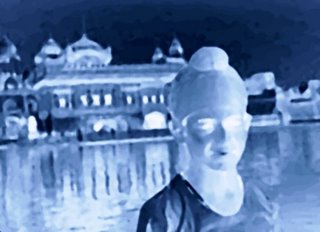 Singhnee: “I have compassion for him and therefore I have brought him with myself, otherwise I could have left him at home. I thought I should not go to Sachkhand alone; I should take a part and parcel of myself also to that holy place. After my death, possibly he may give up his faith as he is of a tender age.”
Singhnee: “I have compassion for him and therefore I have brought him with myself, otherwise I could have left him at home. I thought I should not go to Sachkhand alone; I should take a part and parcel of myself also to that holy place. After my death, possibly he may give up his faith as he is of a tender age.”Kaura Mal: “O God! It is marvellous! What is that stuff of which the hearts of Sikhs are made of? O the pity of it. Will Lakhpat really kill these pious people?”
Singhnee: “This is the blessing of Amrit (Sikh baptism) and the Grace of the Guru. If you love the Sikhs so much as appears from your actions, then please prevent Lakhpat from committing this sin, and fight against him. If there is any problem, inform the Khalsa (God’s Army) living in any of the nearby jungles.”
This appealed to the two Diwans very much. They could not prevent the Singhnee from attending the celebrations which she felt was right. She began reciting her prayers and proceeded to Sri Harmandir Sahib (House of God)....
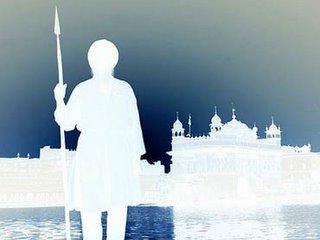
Brave Daughters of the Khalsa

Dhan Dhan Guru De Pyarai
Daughter of Sri Guru Gobind Sahib Ji
Daughter of Mata Sahib Kaur Ji
Fearless Warriors
Courageous Mothers
Determined Daughters
They suffered great in-humane tortues
Watch their children bleed to death
Witnessed the brutual murders of their husbands
Yet, they fought for freedom and faith
Remembered Guru Ji in every breath
And were an Inspiration to all Sikhs
I thank you, Great Mother
I hope to follow your foot steps
I am greatful for your Bravery
We are a Kaur Princess
We are a Brave Lioness
We are the Daughters of the Khalsa
By: FaujKaur
Her child was murdered in her arms…
She faced death with open eyes
Her life was in danger…
She saw so much pain and suffering
Yet as a Daughter of the Khalsa
She fought to the very end with dignity
How strong and magnificent was this Mother and Daughter of the Khalsa Panth...
-Vaheguru...
Click here to Learn more about Shaheed Bibi Balbir Kaur
In Hope of Equality

 Greek philosophers thought a "woman is an unfinished man left standing at a lower step in the scale of development. The male is by nature superior and female inferior. The one is the ruler and the other ruled. Woman is weak of will and, therefore incapable of independence of character and position." Such prejudices prevail even today. On the threshold of a new millennium the status of woman is still to be elevated to that of man.
Greek philosophers thought a "woman is an unfinished man left standing at a lower step in the scale of development. The male is by nature superior and female inferior. The one is the ruler and the other ruled. Woman is weak of will and, therefore incapable of independence of character and position." Such prejudices prevail even today. On the threshold of a new millennium the status of woman is still to be elevated to that of man.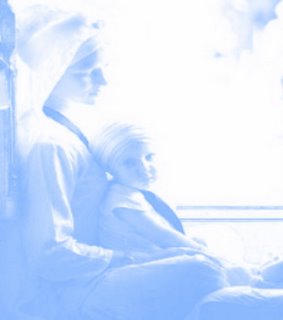 "We are born of woman, we are conceived in the womb of woman, we are engaged and married to woman. We make friendship with woman and the lineage continued because of woman. When one woman dies, we take another one, we are bound with the world through woman. Why should we talk ill of her, who gives birth to kings? The woman is born from woman; there is none without her. Only the One True Lord is without woman" (Guru Nanak Dev, Var Asa, Anng. 473)
"We are born of woman, we are conceived in the womb of woman, we are engaged and married to woman. We make friendship with woman and the lineage continued because of woman. When one woman dies, we take another one, we are bound with the world through woman. Why should we talk ill of her, who gives birth to kings? The woman is born from woman; there is none without her. Only the One True Lord is without woman" (Guru Nanak Dev, Var Asa, Anng. 473)
"They are not said to be husband and wife, who merely sit together. Rather they alone are called husband and wife, who have one soul in two bodies." (Guru Amar Das, Pauri, Anng. 788)
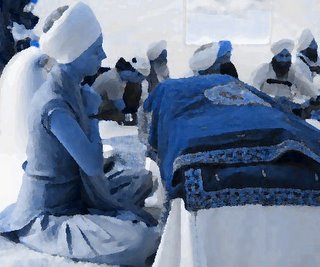
"Come my sisters and dear comrades! Clasp me in thine embrace. Meeting together, let us tell the tales of our Omnipotent Spouse (God). In the True Lord are all merits, in us all demerits." (Guru Nanak Dev, Sri Rag, Anng. 17)
If not, then what are we doing about it?
Sikh women are facing grave challenges while living in western society. They not only have to face glamour-queen stereotyping of the Western culture but the narrow-minded and widely gender-discriminatory society of Eastern culture.
A lot intense pressures come often from restrictive cultural family norms. It is quite easy for the women to falter, become overwhelmed by this dual struggle between two cultures and give in to these pressures.
Sometimes there is a misguided desire to shake off oppression and to rebel against the adoption of the truly liberating Sikhi.
It rests on the shoulders of the whole Sikh Panth to stand up against every act of oppression, discrimination or degradation against women and indeed all people.
It needs to start from our very own households. We must take responsibility, individually in our households, and collectively in our societies, to educate ourselves and our daughters and live the values taught by our Gurus casting off cultural barriers that keep our daughters prisoners.
We must encourage an environment that promotes the growth of Sikh women both as humble servants of the Guru and capable leaders among their communities well-grounded and examples of Khalsa values and heritage.
A question that begs addressing is, if the Gurus advocated equality, why is the typical Sikh woman not treated with equality and independence in Indian/Punjabi society and in many Sikh families? The answer to this riddle lies in the ignorance of many Sikhs with regard to what their own religion preaches about women. When "being Punjabi" is falsely equated with "being Sikh", certain aspects of Punjabi culture, such as overindulgence, oppression of women, tolerance of female infanticide, and belief in caste system, are mistakenly associated with Sikhism. Thus a situation arises where many
Sikhs are following Punjabi cultural norms such as oppression of women, instead of adhering to Sikh beliefs, which were meant to correct such wrongs. The solution to such a problem lies in being able to differentiate between the aspects of Punjabi society that are in accordance with Sikhism, and aspects of Punjabi society that contradict Sikhism. Then those aspects that contradict Sikhism (such as oppression of women) can once and for all be discarded. Then, finally, Sikhs can be proud of not only having a religion that advocates full equality of women, but also having followers that adhere to such ideals.

Pictures: Sikhnet.com, Khalsacamp.com

